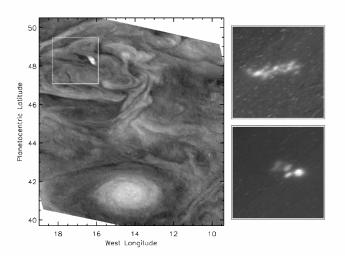
|
Jovian Lightning and the Daytime Storm
- Click the image above for a larger view
- Full-Res JPEG (1152 x 855) (89.4 kB)
- Full-Res TIFF (1152 x 855) (188.1 kB)
Caption:
This picture highlights a convective storm (left panel) and the associated lightning (right panels) in Jupiter's atmosphere. The left image shows the dayside view. The right images show the area highlighted (box) in the dayside view as it appeared 110 minutes later during the night. Multiple lightning strikes are visible in the night side images, which were taken 3 minutes and 38 seconds apart. The bright, cloudy area in the dayside view is similar in appearance to a region of upwelling in Earth's atmosphere. The dark, clear region to the west (left) appears similar to a region of downwelling in Earth's atmosphere. The presence of lightning confirms that this is a site of moist convection.
The lightning originates below the visible ammonia cloud, which acts as a translucent screen, diffusing the light over a wider area. This apparent width can be used to infer the depth of approximately 75 kilometers (46 miles). This figure is consistent with the hypothesis that lightning originates in the Jovian water cloud at about 75 kilometers (46 miles) depth.
To show details of the lightning, the nightside images have been expanded by a factor of two relative to the dayside image. The latitude and longitude scale is shown around the left panel. On Jupiter, one degree of latitude spans a distance of 1,200 kilometers (744 miles), so the highlighted area is approximately 2,400 kilometers (1,488 miles) on a side. The resolution is 23 kilometers (14 miles) per picture element. The dayside image was taken through the 727 nanometer filter with an exposure of 0.529 seconds at 23:03:03 Universal Time on November 7, 1997. The upper night side image was taken through the red filter with an exposure of 166.9 seconds in gain state 1 at 00:49:590 Universal Time on November 8, 1997. The bottom night side image was taken through the red filter with an exposure of 38.9 seconds in gain state 2 at 00:53:37 Universal Time on November 8, 1997. The signal to noise ratio is greater in the lower night side image because the gain state is higher. The images were taken by the solid state imaging camera system on NASA's Galileo spacecraft at a range of 1.1 million kilometers (680,000 miles).
Background Info:
JPL manages the Galileo mission for NASA's Office of Space Science, Washington, DC.
This image and other images and data received from Galileo are posted on the World Wide Web on the Galileo mission home page at http://www.jpl.nasa.gov/galileo.jpl.nasa.gov . Background information and educational context for the images can be found at http://www.jpl.nasa.gov/galileo/sepo ..
Cataloging Keywords:
| Name | Value | Additional Values |
|---|---|---|
| Target | Jupiter | |
| System | Jupiter | |
| Target Type | Planet | |
| Mission | Galileo | |
| Instrument Host | Galileo Orbiter | |
| Host Type | Orbiter | |
| Instrument | Solid-State Imaging (SSI) | |
| Detector | ||
| Extra Keywords | Ammonia, Atmosphere, Grayscale, Storm, Water | |
| Acquisition Date | ||
| Release Date | 1998-10-13 | |
| Date in Caption | 1997-11-07 | 1997-11-08 |
| Image Credit | NASA/JPL-Caltech | |
| Source | photojournal.jpl.nasa.gov/catalog/PIA01638 | |
| Identifier | PIA01638 | |
